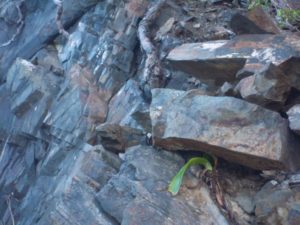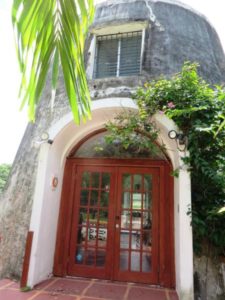St. Croix is known as the “The Don’t Hurry” and our formation was no different. Many of our neighboring Caribbean islands have volcanoes and were formed by volcanic activity; however, there are no volcanoes on St. Croix. Our island can be attributed to a very slow collection of ash, sediment and rocks from volcanic activity starting millions of years ago.
Although details remain a mystery, studies have revealed the general evolution of the island. Particles of sand and mudstone in the sea, likely from the north, were deposited on the ocean floor. Volcanic rock and ash debris, probably from ocean floor volcanoes to the south and southeast, then settled with the sand and mudstone layers.
 Sedimentary rocks are found below the mountain ranges and are likely deep beneath the Central Valley extending from western St. Croix eastward to Beeston Hill and Cane Garden. These rocks are approximately 80 million years old! You can easily identify the oldest exposed rocks by the light-gray sandstone, bluish-black mudstone bands.
Sedimentary rocks are found below the mountain ranges and are likely deep beneath the Central Valley extending from western St. Croix eastward to Beeston Hill and Cane Garden. These rocks are approximately 80 million years old! You can easily identify the oldest exposed rocks by the light-gray sandstone, bluish-black mudstone bands.
There is also great exposure in the Caledonia Valley which is south of Hams Bay and Littlebay Point and east of Monks Bath Beach in the northwest corner of the island. The Valley elevation is 10 feet above sea level and the Caledonia Formation is at least 9000 feet thick.
 The Caledonia Formation grades into a variety of other sedimentary rock formations all containing tuffaceous material, or fragments of altered glass and crystals, deposited originally as volcanic ash. Other St. Croix formations include the Allandale Formation, the Cane Valley Formation, the East End Member and the Judith Fancy Formation. The tuffaceous rocks are often greenish, but are quite variable. The thickness of the tuffaceous formations is approximately 18,000 feet.
The Caledonia Formation grades into a variety of other sedimentary rock formations all containing tuffaceous material, or fragments of altered glass and crystals, deposited originally as volcanic ash. Other St. Croix formations include the Allandale Formation, the Cane Valley Formation, the East End Member and the Judith Fancy Formation. The tuffaceous rocks are often greenish, but are quite variable. The thickness of the tuffaceous formations is approximately 18,000 feet.
Forces beneath the ocean floor compressed the island area, causing folds and depressing the Central Valley area. The trough that separates St. Croix and St. Thomas was probably created at this time. With further uplift, the island of St. Croix emerged as a coral reef at Kingshill, joining the Northside and East End mountain ranges.
 White-to-buff limy rocks, limestone and marl, found at the surface of the Central Valley are actually the remains of a coral reef and date back 20 million years. The limestone has been used extensively as building stone. You’ll see it in many structures in town or in sugar mills. Or if you’re lucky, you may have a historic structure on your property that was built using this stone.
White-to-buff limy rocks, limestone and marl, found at the surface of the Central Valley are actually the remains of a coral reef and date back 20 million years. The limestone has been used extensively as building stone. You’ll see it in many structures in town or in sugar mills. Or if you’re lucky, you may have a historic structure on your property that was built using this stone.
Source: Field Guide to the Geology of St. Croix, U.S. Virgin Islands


Recent Comments